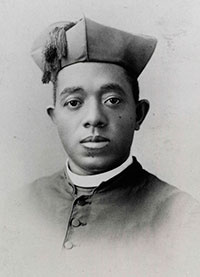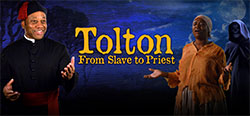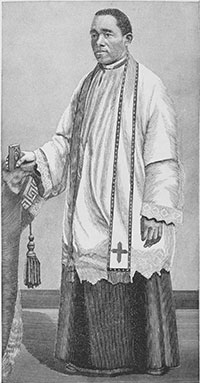 Father Augustus Tolton, a former slave, is the first recognized American diocesan priest of African descent.
Father Augustus Tolton, a former slave, is the first recognized American diocesan priest of African descent.
The canonization cause for Father Augustus Tolton is just one step away from going to Pope Francis for the priest to be declared "venerable."
Tolton was born into slavery on April 1, 1854, at Ralls County, Brush Creek, Mo. Missouri was a slave state at the time, but its populace – a mix of settlers from both northern and southern states – was bitterly divided over the slavery question. Tolton’s mother, Martha Jane Crisley, had come to Missouri with her owners, the Elliotts, a Catholic family from Kentucky. Crisley was a personal maid to Mrs. Elliott and had been baptized in the Roman Catholic Church, as had her husband, Peter Paul Tolton, another Elliott slave. Their two sons – Augustine and his older brother Charley – were baptized in the Church and given religious instruction by Mrs. Elliott, who served as Augustine’s godmother.
When the Civil War erupted, the Tolton family, including 9-year-old Augustus, fled through the woods of northern Missouri and across the Mississippi River while being pursued by Confederate bounty hunters. The small family made their home in Quincy, Ill., a sanctuary for runaway slaves. The boy’s father had died earlier in St. Louis, after escaping slavery to serve in the Union Army.
Growing up in Quincy and serving at Mass, young Augustus felt a call to the priesthood. His parish priest, Father Peter McGirr, admitted the boy into his parish school despite racist threats. Franciscan Fathers noticed Tolton’s intelligence and purity of life and arranged for Tolton to be educated in their college in Quincy and then at the prestigious Pontifical Urban College “de Propaganda Fide” in Rome when no U.S. seminary would accept him because of his background and color.
Following six years of study he was ordained a priest with his class, Easter Vigil April 24, 1886 at St. John Lateran Basilica in Rome.
He assumed he would become a missionary priest serving in Africa. However, after ordination, he was sent back to his hometown to be a missionary to the community there, again facing rampant racism.
“It was said that I would be the only priest of my race in America and would not likely succeed,” Tolton once wrote. But Cardinal Giovanni Simeoni told him, “America has been called the most enlightened nation. We’ll see if it deserves that honor. If America has never seen a black priest, it has to see one now.”
With these prophetic words the assignment orders for Father Tolton changed from some place in Africa to Quincy, Ill.
Father Tolton served faithfully in Quincy for several years, despite enduring racial bigotry from many local Catholics and Protestants as well as jealousy from his fellow priests. He was such a good preacher that many white Catholics joined his black parishioners in the pews for his Masses. This upset white priests in the town, so Father Tolton headed north to Chicago, at the request of Archbishop Patrick Feehan, to minister to the fledgling black Catholic community there.
A year or so later, Father Tolton was given permission to start St. Monica Parish in 1891, on Chicago’s South Side, close to where many local black Catholics lived. The church seated 850 parishioners and was built with money from philanthropist Anne O’Neill and St. Katherine Drexel.
St. Monica’s Parish grew to have 600 parishioners from a base of 30 prior to the construction of the new church building. Father Tolton’s success at ministering to black Catholics quickly earned him national attention within the Church. “Good Father Gus,” as he was called by many, was known for his “eloquent sermons, his beautiful singing voice, and his talent for playing the accordion.”
A newspaper in 1893 described him: “He is a fluent and graceful talker and has a singing voice of exceptional sweetness, which shows to good advantage in the chants of the high Mass. It is no unusual thing for many white people to be seen among his congregation.”
Father Tolton worked tirelessly for his congregation in Chicago, to the point of exhaustion.
Sadly, he died before his new church building could be finished. At the age of 43, during a stifling heat wave that hit the city the week of July 9, 1897, he collapsed from heatstroke while returning from a priests’ retreat.
After a funeral that included 100 priests, Father Tolton was buried in Quincy in the priests’ lot in St. Peter’s Cemetery, which had been his expressed wish.
— Sources: Archdiocese of Chicago, Catholic News Service, the Father Tolton Guild, Wikipedia
More online
At www.toltoncanonization.org: Find out the latest on the canonization cause for Father Tolton, download a prayer card featuring an icon of Father Tolton, and more
At www.catholicnewsherald.com: Read a biography of Father Tolton written by the late Father Roy Bauer, an expert on the black priest’s life and ministry in Quincy, Ill.
Also at www.catholicnewsherald.com: Read about Black Catholic History Month, including more about the Church’s black saints
At www.stlukeproductions.com: Learn more about a play about the life of Father Augustus Tolton, “Tolton: From Slave to Priest.” The play is tentatively scheduled to come to the Diocese of Charlotte in March 2019.
Did you know?
On July 24, 1990, the National Black Catholic Clergy Caucus of the United States designated November as Black Catholic History Month to celebrate the history and heritage of black Catholics. November is significant because two important black saints are commemorated within the month: St. Martin de Porres’ feast day (Nov. 3) and St. Augustine’s birthday (Nov. 13). With All Saints’ Day and All Souls’ Day, we also remember the saints and souls of Africa and the African Diaspora.
Black Catholic history can be traced to the Acts of the Apostles (8:26-40) when St. Philip the Deacon converted the Ethiopian eunuch – one of the first moves the Apostles made to evangelize outside Jerusalem and thus sow the seeds for the universal Church.
Learn more
At www.nbccongress.org: Learn more about the National Black Catholic Congress and its upcoming events, download educational resources and get vocation information
Tolton sainthood cause advances; next step would be 'venerable' decree
-
Tolton sainthood cause advances; next step would be 'venerable' decree
 CHICAGO — The canonization cause for Father Augustus Tolton is just one step away from going to Pope Francis for the priest to be declared "venerable."
CHICAGO — The canonization cause for Father Augustus Tolton is just one step away from going to Pope Francis for the priest to be declared "venerable."On Feb. 5, the feast of St. Agatha, a nine-member Vatican theological commission unanimously voted that Father Tolton's cause be moved forward to the cardinals and archbishops in the Congregation for Saints' Causes for a final vote to send a decree of the priest's "heroic virtues" to Pope Francis for his approval.
Upon the promulgation of that decree, Father Tolton would receive the title "venerable," which indicates he lived the theological virtues of faith, hope and charity and the cardinal virtues of prudence, justice, fortitude and temperance at a heroic level.
The next steps would be beatification and canonization. In general, one miracle attributed to the sainthood candidate's intercession is needed for beatification, and a second such miracle is needed for canonization.
Father Tolton, the first African-American to be ordained a Catholic priest for the United States, was born into slavery, ordained in 1886 in Rome because no U.S. seminary would take him and died serving in Chicago in 1897.
Father James Healy (1830-1900) is considered by some to be the first black U.S. Catholic priest in the U.S. He was biracial; his father was Irish. Born in Georgia, he was ordained in 1854 in Paris for ministry in the U.S. He later became a bishop, heading the Diocese of Portland, Maine.
If canonized, Father Tolton would be the nation's first African-American saint.
"Father Tolton's story represents the long and rich history of African-American Catholics, who have lived through troubling chapters and setbacks in our American history," said Chicago Auxiliary Bishop Joseph N. Perry, archdiocesan postulator for the cause.
"Lessons from his early life as a slave and the prejudice he endured in becoming a priest still apply today with our current problems of racial and social injustices and inequities that divide neighborhoods, churches and communities by race, class and ethnicity. His work isn't done. We will continue to honor his life and legacy of goodness, inclusivity, empathy and resolve in how we treat one another."
Bishop Perry said unexplained physical healings have been reported to the cause and are under investigation.
The Archdiocese of Chicago formally opened Father Tolton's cause for canonization in 2010.
Norbertine Father Gerard Jordan holds the canonical title "promoter of the cause" and travels the country sharing the message of Father Tolton and the canonization efforts on behalf of Bishop Perry.
He said Father Tolton's story transcends the lines of race, gender and priesthood.
"If we start with the black part, then it's just a nice Black History Month story. If we start from the priesthood part you only include the ordained," Father Jordan told the Chicago Catholic, the archdiocesan newspaper. "First off, he didn't start off as a black man or an ordained priest. The first thing that Tolton was was a created child of God. You gotta start there."
"The first experience Tolton would have recognized, and it would have had a physical and spiritual effect on him, was his baptism," Father Jordan said. "If we connect with his baptism, then everybody is included and can relate to his story."
All the baptized are connected, he said.
"The baptism of Tolton tells the real story that we're supposed to be paying attention to and that's the story of the Gospel of Jesus Christ," Father Jordan said. "Everything that Tolton experienced in life is the Gospel story."
Father Tolton had great love for the church, the people of God.
"He saw himself connected to the church who loved him. His mother, Martha Jane, was his physical mother but his spiritual mother was very real to him," Father Jordan said. "He said himself that the Catholic Church was the only thing that would help him to beat the double slavery of his mind and his body."
In his lifetime, Father Tolton also talked about how his mother the church took him as a poor slave to become fully who he was in the eyes of God.
"Everybody has to realize that the greatest inheritance we will ever receive is our baptism," Father Jordan said. "It is your decision whether or not you're going to keep that inheritance and invest in it or whether you're going to squander it or give it away or abandon it. Tolton never abandoned his inheritance."
His story begins and ends there, the priest said.
"Once people relate to Tolton's baptism they will find pieces of their life that they can relate too."— Joyce Duriga, Catholic News Service



 CHICAGO
CHICAGO